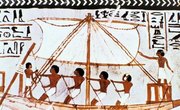By 1800, the trade in beaver fur centered on North America, as the European beaver had long since been hunted to scarcity. The most desirable hats throughout much of the world were made from beaver felt, and their popularity meant an insatiable demand for beaver pelts. The demand did not slow until the American beaver also became scarce by the mid-19th century -- and silk hats became popular.
Beaver Trade
The fur trade in North America brought the Native Americans into a global economy, as fur products were important overseas trade items. In exchange, Native Americans acquired European-manufactured items such as guns, knives, glass beads, metal cooking pots and blankets. The beaver, in particular, was a key product in the fur trade, and many pelts trapped in North America ended up in markets in England, France and Russia. By the 19th century, many fur traders remained year-round with the tribes to engage in fur exchanges.
Beaver Felt Hats
Gentlemen in 19th century Europe wore beaver felt hats as statements of social status and wealth. The most expensive hats were made almost entirely of beaver felt, but cheaper hats, or demi-castors, made from blended wood were also available. Like all rodents, beaver skin contains a soft under-fur with barbed hairs ideal for felt-making. The process of making beaver felt for hats was laborious. Hatters, or hat factory employees, physically removed the outer guard hairs, then they subjected the under-fur to a mercury solution to raise the barbs in the hair. The hairs would mat easily to form the felt, which then required an even more laborious process to form and shape into a hat.

Beaver Coats
Two types of beaver fur were traded in the 1800s. The most valuable were called castor gras, or coat, pelts, and these were actually sewn together and worn next to the body for a season. Both Native Americans and fur traders wore beaver coats in this fashion to keep themselves warm for a winter -- but also to increase the beaver pelts’ value. Wearing the furs made them more pliable and wore away the unwanted guard hairs. This meant less labor for the hatters who processed the hides. Castor sec pelts were simply processed but not worn, and more labor was required to remove the guard hairs, which decreased their value.
Beaver Trade Decline
Before the arrival of Europeans, an estimated 60 million beavers thrived in North America. They are believed to have existed in more than 85 percent of waterways, and more than 100,000 pelts were traded annually by the 17th century. Two events led to the demise of the beaver trade. The first was simply overhunting and trapping; by the 1830s, North American beaver had become scarce. By 1900, they were a rare sight. Secondly, by the 1830s, fashion had made silk hats more desirable than beaver felt, and the price for beaver pelts plummeted.
Related Articles
References
- University of California Santa Cruz Center for World History: A Brief History of the Beaver Trade
- University of Virginia's American Studies Project: The Fur Trade: "Beaver Powered Mountaineering"
- McGill University Library: The Beaver and Other Pelts
- Economic History Association: The Economic History of the Fur Trade: 1670 to 1870
- Canadian Geographic: Rethinking the Beaver
Resources
Writer Bio
John Peterson published his first article in 1992. Having written extensively on North American archaeology and material culture, he has contributed to various archaeological journals and publications. Peterson has a Bachelor of Arts from Eastern New Mexico University and a Master of Arts from the University of Nebraska, both in anthropology, as well as a Bachelor of Arts in history from Columbia College.











